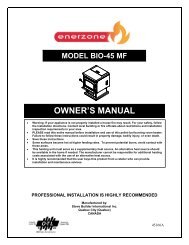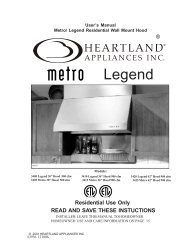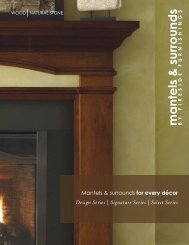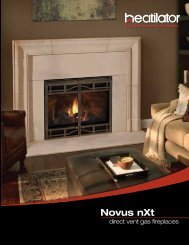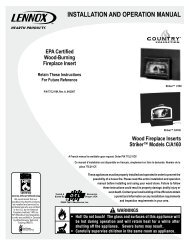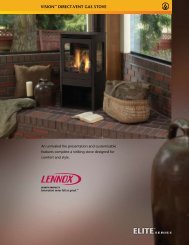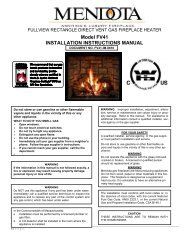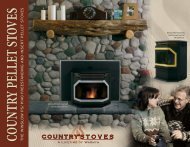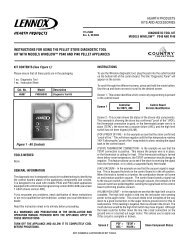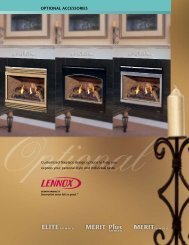5700 WOOD STOVE - Hearth & Home Technologies
5700 WOOD STOVE - Hearth & Home Technologies
5700 WOOD STOVE - Hearth & Home Technologies
Create successful ePaper yourself
Turn your PDF publications into a flip-book with our unique Google optimized e-Paper software.
R<strong>5700</strong> ACT Wood StoveMAINTENANCE and GLASS CARECREOSOTEFORMATION AND NEED FOR REMOVAL: When wood isburned slowly, it produces tar and other organic vaporswhich combine with expelled moisture to form creosote.The creosote vapors condense in the relatively coolchimney flue of a newly-started or a slow-burning fire. Asa result, creosote residue accumulates on the flue lining.When ignited, this creosote creates an extremely hot firewhich may damage the chimney or even destroy the house.The chimney connector and chimney should be inspectedonce every two months during the heating season todetermine if a creosote or soot buildup has occurred. Ifcreosote or soot has accumulated, it should be removedto reduce the risk of a chimney fire.INSPECTION: Inspect the system at the stove connectionand at the chimney top. Cooler surfaces tend to buildcreosote deposits quicker, so it is important to check thechimney from the top as well as from the bottom.REMOVAL: The creosote or soot should be removed witha brush specifically designed for the type of chimney inuse. A chimney sweep can perform this service. It is alsorecommended that before each heating season the entiresystem be professionally inspected, cleaned and repairedif necessary.CHIMNEY CLEANINGRemove all ash from the firebox and extinguish all hotembers before disposal. Allow the stove to cool completely.Disconnect flue pipe or remove baffle from stove beforecleaning chimney. Otherwise residue can pile up on top ofthe baffleand the stove will not work properly. Close thedoor tightly and proceed with sweeping the chimney. Cleanout fallen ashes from the firebox.Disposal of ashesAshes should be placed in a metal container with a tightfitting lid. The closed container of ashes should be placedon a noncombustible floor or on the ground, well away fromall combustible materials, pending final disposal. If theashes are disposed of by burial in soil or otherwise locallydispersed, they should be retained in the closed containeruntil all cinders have thoroughly cooled.OVERFIRINGDo not overfire. Using flammable liquids or too muchwood, burning trash in the stove, or allowing too muchair into the stove may result in overfiring. If the chimneyconnector or stove glows red or even worse, white, thestove is overfired. This condition may ignite creosote inthe chimney, which can be dangerous, possibly causinga house fire. If you overfire, immediately close the aircontrols and door, if open, to reduce the air supply to thefire. Overfiring will void the stove warranty.FIREBRICKThe firebox of your Quadra-Fire stove is lined with high qualityfirebrick, which has exceptional insulating properties. There is noneed to use a grate; simply build a fire on the firebox floor of yourstove. Do not operate stove without firebrick.GLASS CARENOTE: Remove all labels from glass before lightingthe first fire in your stove.Quadra-Fire stoves are equipped with ceramic super heat-resistantglass, which can only be broken by impact or misuse. Do not slamstove door or impact the glass. When closing door, make surethat logs do not protrude against the glass. Clean glass with anonabrasive glass cleaner, such as Windex. Abrasive cleaners mayscratch and cause glass to crack. Inspect glass regularly. If you finda crack or break, immediately put the fire out and return the door toyour dealer for replacement of glass before further use.A portion of the combustion air entering the firebox is deflecteddown over the inside of the door glass. This air flow “washes” theglass, helping to keep smoke from adhering to its surface. Whenoperated at a low burn rate, less air will be flowing over the glassand the smokey, relatively cool condition of a low fire will cause theglass to become coated. Operating the stove with the Primary AirControl all the way open for 15-20 minutes should remove the builtup coating. If the deposits on the glass are not very heavy, normalglass cleaners work well. Heavier deposits may be removed by usinga damp cloth dipped in wood ashes or by using a commerciallyavailable oven cleaner. After using an oven cleaner, it is advisableto remove any residue with a glass cleaner or soap and water. Ovencleaner left on during the next firing can permanently stain the glassand damage the finish on plated metal surfaces.CARE AND CLEANING OF PLATED SURFACESClean plated surfaces with vinegar or a glass cleaner beforelighting your first fire.CAUTION: Do not use polishes with abrasives as it will scratchthe surface.WARNING: When the appliance is equipped with a plated door,you must clean all the fingerprints and oils from the surface beforefiring the appliance for the first time. Use a glass cleaner or vinegarand towel to remove the oils. If not cleaned properly before lightingyour first fire, the oils can cause permanent markings on the plating.After the plating is cured, the oils will not affect the finish and littlemaintenance is required: just wipe clean as needed.Page 22250-7090ESeptember 1, 2008



